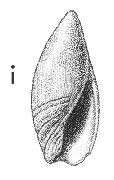
Revised descriptions of New Zealand Cenozoic Mollusca from Beu and Maxwell (1990)

 | Revised descriptions of New Zealand Cenozoic Mollusca from Beu and Maxwell (1990) | 
|
  (Pl. 42i): GS 10849, V20/f8572, Devil's Elbow mudstone, top of north face of Devil's Elbow hill, Napier-Wairoa highway, late Nukumaruan (GNS) |
Beu & Maxwell (1990): Chapter 15; p. 325; pl. 42 i.
Synonymy: Ancillaria novaezelandiae G. B. Sowerby II 1859, in 1842-1877, p. 65; Ancilla (Anaulax) nana Watson 1886, p. 230; Ancilla bicolor "Gray" of Suter 1913c, p. 453 (error for A. tricolor Sowerby, but not that species); Ancilla crystallina Brookes 1926, p. 433; Baryspira (Gracilispira) firthi Olson 1956, p. 26; Baryspira novaezelandiae
Type species of Gracilispira Olsson, 1956
Classification: Olividae: Ancillinae
Description: Small for genus (10-15 mm high, a few specimens to 25 mm high), tall and narrow, with tall, weakly inflated spire and very narrowly rounded apex. Lower margin of spire callus an obvious spiral line just below top of outer lip, descending to left of aperture in weakly sigmoidal line to fuse with inner lip. Depressed band narrow, at 0.7 lip height on left side of inner lip, descending around last whorl to produce low nodule on outer lip just above anterior end. Top fasciolar band and mid fasciolar band weakly separated, the 2 combined equal in width to basal fasciolar band; basal band separated from base of columella by deep, narrow groove; columellar base bearing 5 low plaits.
Comparison: We can see no differences between the types of Baryspira firthi Olson (23.8 mm high; holotype) and the larger specimens of Amalda novaezelandiae, and there is no reasonable doubt that these names are synonyms. Another probable synonym is Baryspira rimuensis Olson (1956, p. 27) (Mangapanian, Te Rimu Sand, Wanganui River); Olson gave no criteria for distinguishing B. rimuensis from A. novaezelandiae and we can see no distinguishing characters, but more material of pre-Nukumaruan age is needed to be sure of the variation of A. novaezelandiae. In many fossils, the original colour is retained to some degree (pale brown whorl sides, as far down as mid-fasciolar band; spire, inner lip and base white).
Distribution: Opoitian-Recent. Recent, New Zealand (types of A. novaezelandiae, A. nana, A. crystallina); Livingstone Bridge, Rangitikei River, Wanganui basin, Nukumaruan (type of B. firthi). Abundant and widespread throughout New Zealand in all shelf soft-bottom facies of Pliocene and Pleistocene age.
Cite this publication as: "A.G. Beu and J.I. Raine (2009). Revised
descriptions of New Zealand Cenozoic Mollusca from Beu and Maxwell (1990). GNS
Science miscellaneous series no. 27."
© GNS Science, 2009
ISBN
978-0-478-19705-1
ISSN 1177-2441
(Included with a PDF facsimile file
copy of New Zealand Geological Survey Paleontological Bulletin 58 in CD version
from: Publications Officer, GNS Science, P.O. Box 30368 Lower Hutt, New
Zealand)